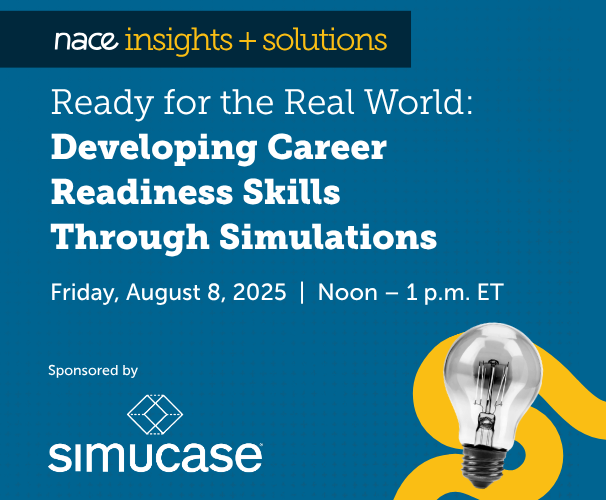With an eye toward the future of its workforce, Mohawk Industries provides its candidates and new college hires with development that extends beyond the internship.
Specifically, the company offers college students programming and experience that develop and sharpen career readiness competencies through its internship program—called “Engage”—and then through its “Aspire” program, which is Mohawk’s college graduate rotational program.
“These programs allow us to develop holistic, future-ready employees,” says Ryan Elder, director of talent development.
“For us, every individual who we bring through our doors is an investment in shaping the future of our organization. We look at internships holistically from our engagement process, which allows us to bring students into the organization, give them some exposure, and assess what our future employee base is going to be.”
See Elder and Dr. Nguyen at NACE22
Ryan Elder and Dr. Jessica Nguyen will present “ENGAGE and ASPIRE: How We Continue Student Development Past the Internship” at the NACE 2022 Conference & Expo in Portland, Oregon.From there, Elder continues, Mohawk continues that development in partnership with its new hires throughout their careers.
“This is why we have such a strong focus on the internship program transitioning into the next iteration, which is our Aspire program,” he says.
Dr. Jessica Nguyen, Mohawk’s university relations manager who has a background in career services, says that she saw first-hand on the college side that students were not proficient in the competencies yet.
“Also, we heard from faculty that students were not demonstrating competencies in the classroom,” she says.
“Research and my own experiences have shown that there is still a need for students improve upon their soft or essential skills. It’s important for us to help students develop these competencies while they are still in college because they will need them in the real world and workforce. We want to make sure we’re providing them a with holistic experience by providing competency development while they’re doing their internship and gaining those more technical skills as well.”
Mohawk surveys its interns midway through the summer and upon completion of their internship to assess their proficiency in the career readiness competencies. It also provides professional development opportunities throughout the summer.
“We try to base our programming off of the competencies that, in recent years, hiring managers have identified as area students are lacking in,” Dr. Nguyen says.
“We also have each of our hiring managers fill out a project charter to identify the skills they are going to be developing and the expected learning outcomes.”
As new college hires move beyond the internship program and take the next step into the workforce, Mohawk focuses on developing nine core competencies.
“This gives us a way to bridge the gap so we can transition the student in terms of career readiness to a better way of thinking about employability as they can demonstrate their skills and capabilities in the real world,” Elder says.
“Our nine core competencies map well to NACE’s career readiness competencies. It’s not a one for one, but we can create synergy between the two sets. We use that within my team from a talent development component to make sure we are speaking the same language.”
Aspire focuses on the three E’s: engagement, education, and exposure:
- Engagement—This includes building a sense of community among new college hires and engaging their leaders through projects that have real world applicability.
- Education—Mohawk holds lunch and learns throughout the internships and quarterly development throughout the rotational program to make sure it is adding to their knowledge base.
- Exposure—Mohawk gives program participants opportunities to demonstrate their knowledge and learning. Interns present the projects that they worked on to leadership during an intern expo. Meanwhile, Aspire participants are coached throughout to give a presentation to senior leadership at the end of their rotations to talk about the projects they worked on, how they mapped to the organization, and the value add they were able to provide back to the business in terms of both equity with respect to dollar value, but also impact on the organization through cost savings, productivity, and more.
Mohawk also provides mentors for all Aspire participants and is adding mentorship for all its interns this summer.
Elder explains that oftentimes, organizations get so caught up in and focus on the end result of what they are trying to deliver that they fail to focus on the employees’ journey.
“However,” he says, “the journey is so critically important for individuals who are younger in their career.
“We go through an extensive journey-mapping process as we design these programs. We focus on each step of the journey and the knowledge bases and deliverables from a project basis. We stack knowledge on top of that so that every step along the way, there are signposts that we can look at to determine if each individual is progressing, demonstrating the desire to continue to grow, walking away with the key learnings that we want them to, or needs more support.”
Elder and Dr. Nguyen offer several other suggestions for developing effective career readiness programs during and after internships:
- Create space for self-reflection—When looking at development holistically across organizations at any level, it is focused on consuming information and then going out and applying it. Mohawk is very intentional in providing program participants with the tools to be able to effectively self-reflect at different stages over the course of their career. That process of debriefing, whether it's by themselves or with another individual, to assess where they are and then charting a course into the future is a critical skill.
- Find champions within the organization and involve them—Find champions who believe in the programs and run them well. Mohawk grew its internship program from 78 interns last year to approximately 120 this year. That growth came, in large part, from inviting employees to last year’s intern expo to show them what the interns are capable of accomplishing and contributing to the teams and the organization, sparking heavy interest in joining the effort.
- Partner with schools and give the relationship time to grow—Mohawk says it takes at least a year of being on campus and branding—whether during in-class presentations, resume reviews, mock interviews, or more—for students to know the company and want to engage with it. Be patient and willing to work to develop these key relationships.
“In the talent space, we are often asked to quantify the value of what we do in terms of cost savings or some other measure,” Elder says.
“I spoke with our leadership the other day and the sentiment is that if you’re ever asked to quantify talent development within your organization, then they’re not thinking about talent in the right way. It is an imperative that we grow our internship program and that we continue expand our college graduate rotation program because we know that good talent is difficult to find, and we are going to pay a premium on the market.
“This isn't something that's a ‘nice to have’; for us, it's an absolute necessity. If you're thinking about this as a ‘nice to have,’ and you're getting pushback because you're trying to quantify something, then you have not built a value proposition for talent within your organization effectively. Think about whether you have the right mindset within your organization to go forward full force on this or if you need to go back and build the value proposition within your teams and your leadership.”






